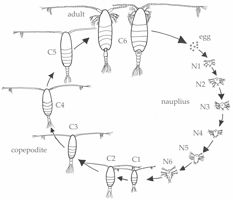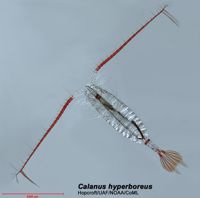Drifting microscopic organisms called 'plankton' are be found in every ocean, lake, and freshwater body of the world.
The smallest members, microbial plankton and phytoplankton, form the base of the food web, recycling organic materials and turning sunlight into new materials.
Tiny planktonic predators, zooplankton and ichthyoplankton, capture these materials (and each other) and continue the food web into larger and larger zooplankton, fish, birds, whales, and humans.
A "copepod" is a type of zooplankton, a planktonic crustacean distantly related to shrimp and crabs. Copepods are one of the most common and easily recognized types of zooplankton, found in almost every ocean, sea, and freshwater habitat, even in underground caverns.
Copepods hatch from eggs, spending the first part of their lives as a mite-like, larval "nauplius".
The nauplii then molt into a juvenile "copepodite" stage, which has a form similar to the adult.
The copepodites eventually develop into the adult form when they sexually mature.
In this case, COPEPOD is an acronym for the Coastal & Oceanic Plankton Ecology, Production, & Observation Database, a global plankton database that contains over 400,000 observations of copepods, along with other zooplankton, phytoplankton, and microbial plankton taxa.
The COPEPOD project is an effort by the National Marine Fisheries Service (NMFS, aka "NOAA Fisheries") to provide fisheries and marine ecosystems investigators with an integrated data set of quality-reviewed, globally distributed plankton data, along with any available co-sampled environmental hydrographic and meteorological data. These data are provided in a variety of forms (e.g., spatial mean fields, time-series, graphical maps and figures) and compilations (e.g., from individual data sets to regional or taxa-based compilations).
|
|

Illustration of the copepod life cycle and its life stages.

Photograph of Calanus hyperboreus, a calanoid copepod species found in the cooler North Atlantic and Arctic waters. (See also COPEPEDIA.)
|
|